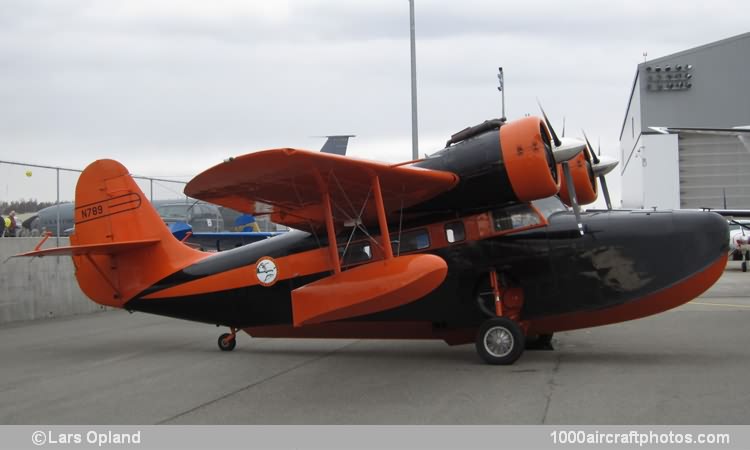10/31/2012. Remarks by Johan Visschedijk: "In 1936 a group of ten wealthy businessmen and sportsmen in and around New York City, led by Wilton Lloyd-Smith, formed a syndicate to investigate the possibility of having a personal transport and a commuter between their Long Island estates and the Wall Street waterfront. They went to Grover Loening, well-known for the Air Yacht and other amphibious designs, who drew the specification for a two-engine amphibian, and advised the Grumman Aircraft Engineering Corporation of Bethpage, New York, as manufacturer.
Roy Grumman and Bill Schwendler laid out the preliminary design, detail design was done by project engineer Ralston Stalb, formerly chief engineer at Loening. Of all-metal construction with a two-step hull, the design of which was based on the central float of the earlier J2F-1 Duck amphibious floatplane, the G-21 was powered by two 450 hp Pratt and Whitney R-985-SB Wasp Junior engines and flew for the first time by Bud Gillies and Bob Hall on May 30, 1937.
The principal commercial production model was the G-21A which differed from the original G-21 in having a 500 lb (227 kg) increase in loaded weight and R-985-SB2 engines. The first military adaptation of the amphibian was ordered by the USAAC which placed a contract for 26 machines in 1938, these being intended for the utility role under the designation G-31 OA-9. This order was later to be supplemented by five impressed civil machines which were also designated OA-9, three G-21As with R-985-AN1 engines which, impressed in 1942, were designated OA-13As, and two USN JRF-5s which, equipped for the dual photographic-utility role, entered service in 1945 under the designation OA-13B.
The USN also evinced an interest in the G-21A from an early stage, accepting one machine for evaluation on September 9, 1938 as the G-26 XJ3F-1. Ten production aircraft followed to the USN in 1939 under the designation G-38 JRF-1. While essentially eight-seat utility transports, these aircraft could be fitted for target-towing and photography as the JRF-1A. Another ten aircraft were ordered for the USCG, these being delivered for air-sea rescue duties in 1940. Seven of these were designated G-39 JRF-2 (V174 to V176 c/n 1063 to 1065, V184/V187 c/n 1076/1079) and the remaining three (V190 to V192 c/n 1085 to 1087) were fitted with anti-icing equipment and autopilot to suit them for rescue duties in Northern waters, these being designated G-39 JRF-3.
The G-39 JRF-4 was basically similar to the JRF-1 but was intended for coastal anti-submarine patrol, bomb racks for two 250 lb (113 kg) bombs being fitted immediately outboard of the engine nacelles. Ten aircraft of this type were delivered to the USN. The first large-scale production model was the G-38 JRF-5 fitted for photographic work and having R-985-AN6 engines. Of the 190 machines of this type ordered, six were delivered to the USCG for rescue duties as the JRF-5G. Six amphibians of this type were delivered to the RAF as the Goose Mk.I, and a further 29 were delivered to the RCAF for use among other roles as navigational trainer.
The G-38 JRF-6 differed in having later electrical and radio equipment, and the JRF-6B was fitted with blister windows and carried navigational training equipment. Fifty aircraft of the last-mentioned version were supplied to the RAF under the Lend-Lease Program in lieu of fifty G-21As ordered in 1940 by the British Purchasing Commission and taken over by the USN early in 1941. Designated Goose Mk.1A, these served as utility transports with No. 24 Squadron, for ferry duties with the Air Transport Auxiliary and for air-sea rescue.
The G-21B was similar to the G-21A, but without wheels and equipped as utility and patrol seaplane, it was the only pure seaplane type. It had an armament of one 0.30 in (7.62 mm) fixed and one 0.30 in (7.62 mm) flexible machine guns and two 100 lb (45 kg) bombs. Twelve were supplied to the Portuguese Naval Air Service, registered for testing in the USA as NX97 to NX108.
The pictured Goose was produced for the USN as a G-38 JRF-5 under BuNo. 84807, and was accepted on November 29, 1944; upon withdrawal from use it was stored at Phoenix, Arizona. Demilitarized and redesignated G-21A it was registered as N789 in 1956 and transferred to the US Fish & Wildlife Service for operations in Alaska. On October 24, 1996, the aircraft was sold to the Alaska Aviation Heritage Museum (since renamed Alaska Aviation Museum) at Anchorage, Alaska, where it is preserved in flying condition."
